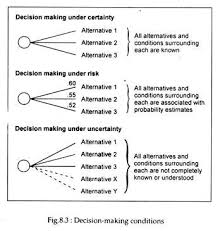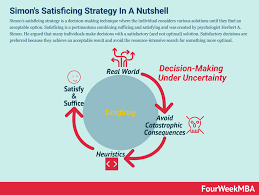Title: The Key to Effective Management: Understanding the Managerial Decision-Making Model
Introduction:
In today’s fast-paced and complex business environment, managers play a crucial role in making decisions that can impact the success of their organizations. To navigate through the challenges and uncertainties, managers rely on a structured approach known as the managerial decision-making model. This article aims to shed light on this model, its components, and how it aids managers in making effective decisions.
Identification of the Problem:
The first step in the managerial decision-making model is identifying the problem or opportunity that requires attention. This involves recognizing issues, analyzing trends, and understanding potential risks and rewards associated with different courses of action.
Gathering Information:
Once a problem is identified, managers must gather relevant information from various sources to gain a comprehensive understanding of the situation. This includes data analysis, market research, customer feedback, and input from team members or experts.
Generating Alternatives:
With sufficient information at hand, managers proceed to generate a range of alternatives or potential solutions to address the identified problem. Encouraging creativity and diverse perspectives within the team can lead to innovative ideas that may not have been initially apparent.
Evaluating Alternatives:
In this stage, managers critically evaluate each alternative based on predetermined criteria such as feasibility, cost-effectiveness, risk assessment, and alignment with organizational goals. This evaluation helps narrow down options to those that are most likely to yield positive outcomes.
Making the Decision:
After careful evaluation of alternatives, managers make a final decision by selecting one option that best aligns with their analysis and judgment. It is essential for managers to consider both short-term gains and long-term implications when making decisions that impact their organization’s overall performance.
Implementation:
Once a decision is made, effective implementation becomes crucial for its success. Managers need to develop an action plan outlining specific steps required for execution while considering resource allocation, timelines, and potential challenges that may arise during the implementation process.
Evaluation and Feedback:
The managerial decision-making model emphasizes the importance of continuously evaluating the outcomes of decisions and seeking feedback from stakeholders. This allows managers to assess whether the chosen solution is achieving desired results or if adjustments need to be made.
Conclusion:
The managerial decision-making model serves as a valuable framework for managers to approach complex problems and make informed choices. By following a structured process that incorporates problem identification, information gathering, alternative generation, evaluation, decision-making, implementation, and evaluation, managers can enhance their ability to make effective decisions that drive organizational success.
Understanding this model equips managers with the necessary tools to navigate uncertainty, mitigate risks, seize opportunities, and ultimately steer their organizations towards growth and prosperity.
Commonly Asked Questions About Managerial Decision-Making Models
- What are the four models of decision-making?
- What are the 5 decision making models?
- What are the 3 models of decision-making?
- What are the 5 steps in the managerial decision-making process?
What are the four models of decision-making?
There are several models of decision-making, but four commonly recognized ones are:
Rational Decision-Making Model:
The rational decision-making model is a systematic and logical approach to decision-making. It involves identifying the problem, gathering relevant information, generating and evaluating alternatives, selecting the best option based on predetermined criteria, implementing the decision, and evaluating the outcomes. This model assumes that decision-makers are rational, have complete information, and aim to maximize their outcomes.
Bounded Rationality Model:
In contrast to the rational model, the bounded rationality model acknowledges that decision-makers have limitations in processing information and making fully rational choices. In this model, individuals make decisions that are “good enough” or satisfactory rather than optimal. They use heuristics (mental shortcuts) to simplify complex situations and rely on past experiences or intuition to make decisions.
Incremental Decision-Making Model:
The incremental decision-making model suggests that decisions are made gradually over time by making small adjustments or modifications to existing practices or solutions. This approach is often used when dealing with complex or uncertain situations where it may be difficult to determine a single best solution upfront. Decision-makers continuously learn from feedback and adapt their decisions incrementally as new information becomes available.
Intuitive Decision-Making Model:
Intuitive decision-making relies on instinct, gut feelings, or unconscious knowledge rather than a deliberate analytical process. This model suggests that experienced individuals develop expertise in certain domains and can make quick decisions based on their intuition without going through extensive analysis. Intuition is often developed through years of experience and pattern recognition.
It’s important to note that these models provide frameworks for understanding how decisions are made but may not fully capture the complexities of real-life decision-making processes. Decision-making often involves a combination of these models depending on the context, individual preferences, available information, and time constraints.
What are the 5 decision making models?
There are several decision-making models that have been developed over the years. Here are five commonly used decision-making models:
Rational Decision-Making Model:
The rational decision-making model is a systematic and logical approach to decision making. It involves identifying the problem, gathering relevant information, generating alternatives, evaluating those alternatives based on predetermined criteria, making a choice, implementing the decision, and finally evaluating the outcome.
Bounded Rationality Model:
The bounded rationality model recognizes that individuals have limitations in processing information and making decisions. It suggests that decision makers tend to make satisfactory rather than optimal choices due to time constraints, limited information, and cognitive biases.
Intuitive Decision-Making Model:
Intuitive decision-making relies on instinct, experience, and gut feelings rather than a structured analysis of information. This model is often used when time is limited or when dealing with complex situations where there may not be enough data available for a rational analysis.
Incremental Decision-Making Model:
The incremental decision-making model involves making decisions gradually by taking small steps or adjustments over time. This approach allows for flexibility and learning through experimentation while minimizing potential risks associated with large-scale decisions.
Participative Decision-Making Model:
The participative decision-making model involves involving multiple stakeholders in the decision-making process. This collaborative approach seeks input from individuals who will be affected by or have expertise in the decision being made. It promotes employee engagement, consensus-building, and better acceptance of final decisions.
It’s important to note that these models provide frameworks for understanding different approaches to decision making but may not fit every situation perfectly. The choice of which model to use depends on factors such as the nature of the problem, available resources, time constraints, and individual preferences or organizational culture.
What are the 3 models of decision-making?
There are several models of decision-making, but three commonly recognized ones are the Rational Decision-Making Model, the Bounded Rationality Model, and the Intuitive Decision-Making Model. Let’s take a closer look at each:
Rational Decision-Making Model:
The Rational Decision-Making Model is a systematic and logical approach to decision-making. It assumes that individuals make decisions by identifying and evaluating all possible alternatives based on objective criteria. The steps involved in this model include problem identification, information gathering, alternative generation, evaluation, decision-making, implementation, and evaluation of outcomes.
Bounded Rationality Model:
The Bounded Rationality Model acknowledges that individuals have limitations in processing information and making decisions due to time constraints, cognitive biases, and limited resources. In this model, decision-makers strive to make rational choices within the bounds of their cognitive abilities and available information. They may rely on simplified decision rules or satisficing (choosing an option that meets minimum requirements) rather than exploring all possible alternatives.
Intuitive Decision-Making Model:
The Intuitive Decision-Making Model emphasizes quick and instinctive decision-making based on past experiences, gut feelings, or tacit knowledge. This model suggests that experienced decision-makers can rely on their intuition to make effective decisions without going through an extensive analytical process. Intuition is often developed through years of experience and practice in a specific domain.
It’s important to note that these models are not mutually exclusive but rather represent different approaches to decision-making. Managers often employ a combination of these models depending on the nature of the problem they face, time constraints, available information, and their own expertise and preferences.
What are the 5 steps in the managerial decision-making process?
The managerial decision-making process typically involves the following five steps:
- Problem Identification: The first step is to recognize and define the problem or opportunity that requires attention. This may involve identifying a gap, a challenge, or an area for improvement within the organization.
- Gathering Information: Once the problem is identified, managers gather relevant information from various sources to gain a comprehensive understanding of the situation. This includes collecting data, conducting research, seeking input from team members or experts, and analyzing available information.
- Generating Alternatives: With sufficient information at hand, managers generate a range of potential solutions or alternatives to address the identified problem. Encouraging brainstorming sessions and considering diverse perspectives can help in generating innovative ideas.
- Evaluating Alternatives: In this step, managers critically evaluate each alternative based on predetermined criteria such as feasibility, cost-effectiveness, risk assessment, and alignment with organizational goals. This evaluation helps in narrowing down options to those that are most likely to yield positive outcomes.
- Making the Decision: After careful evaluation of alternatives, managers make a final decision by selecting one option that best aligns with their analysis and judgment. They consider both short-term gains and long-term implications when making decisions that impact their organization’s overall performance.
It’s important to note that decision-making is an iterative process, and these steps may not always follow a linear sequence. Managers often revisit previous steps as new information emerges or circumstances change. Additionally, effective implementation and continuous evaluation are crucial for successful decision outcomes beyond these initial steps in the decision-making process.




